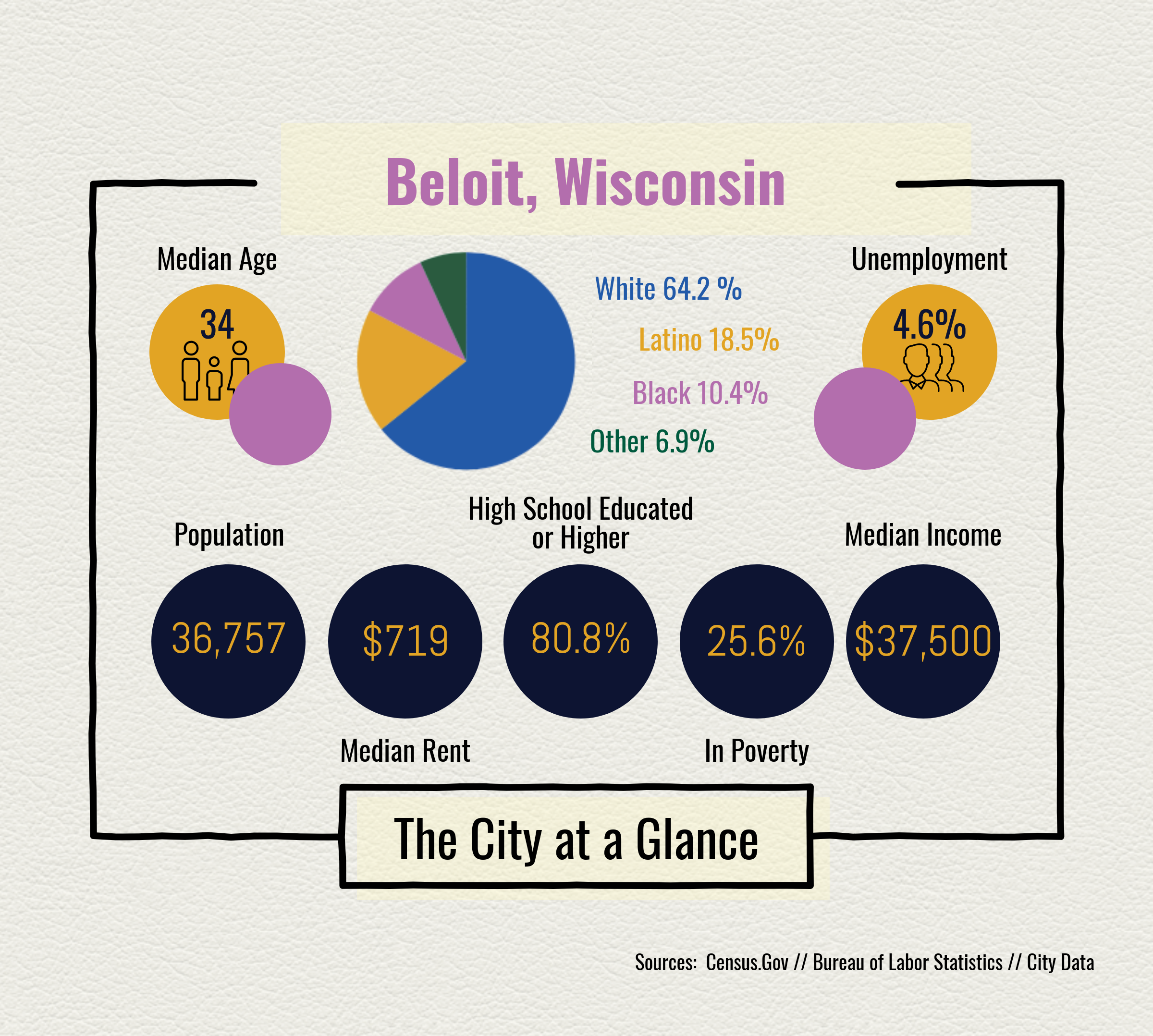The revitalization of Beloit, Wisconsin, has community members in a tug-of-war for its control
Smack-dab on the Wisconsin-Illinois border lies Beloit, a small, industrial town of approximately 37,000 people. Within the city’s limits, you can enjoy high-class dining at Merrill & Houston’s Steak Joint, walk along the Rock River’s edge and even attend a Snappers semi-professional baseball game –– all while enjoying the feel of your average, Midwestern town.
Originating from the hands of a few powerful elites, these recent projects have allowed Beloit to keep pace with other Wisconsin cities. Local billionaire power couple Diane and the late Ken Hendricks, Beloit 2020 and the Greater Beloit Economic Development Corporation are among those piloting these revolutionary development projects.
Although these projects bring jobs to the city through their construction and maintenance and provide new attractions for those from in and around the city, some are left wanting more for the city. While Beloit’s shifting blueprint has appeared to put it on the up and up, a number of structural issues continue straining its foundation. As shiny, new high rises and trendy sushi bars open along Beloit’s State Street, the city continues its struggle with crime, poverty and the added consequences left by the developments.
The newest plan to expand the Beloit Memorial High School campus puts rental properties on the market to make room for new additions, thus displacing Sixth Street’s primarily low-income residents and forcing them to relocate.
José Gutierrez and his family landed in Beloit eight years ago, spending their first years on Sixth Street. After journeying from Mexico to California and Illinois, the lower housing and education costs drew the family to Wisconsin.
Now, after moving to Vine Street, a mere two blocks away from their first home, Gutierrez finds himself stuck between appreciating the generosity of investors and questioning their motivations on a project that hits so close to home. He believes that these developments emphasize an already-present dynamic between Beloit’s “haves” and “have-nots.”
“The progression of Beloit and the development kind of uphold that standard and put in a divide between people that can afford this stuff and people that can’t,” Gutierrez says.
Despite this apprehension, the projects come with very little reservation from the greater community. Beloit’s city manager and council give each project almost unanimous approval, Beloit School District staff continue to show support for the high school renovation, and the majority of Beloit’s white, middle-class residents seem to think the additions are exactly what the city needs.
This lack of concern is exactly what another portion of Beloit’s population finds so frustrating. Before relocating to California this past September, longtime Beloit resident and City Council member Sheila De Forest decided to confront this unquestioning majority. With a history of advocating for Beloit’s most marginalized groups, De Forest became frustrated with city leadership’s lack of attention to the developments’ wider social impacts.
In her 2016 parting statement to the City Council, De Forest wrote: “Beautiful spaces are important, but without strong, vibrant, healthy neighborhoods and thriving people, only those who are well-off or visiting from out of town have the luxury of enjoying those wonderful spaces and reaping the rewards. As City Councilors, our responsibility is to represent the people and ensure that we keep the safety and welfare of the residents as our highest charge.”

Historically, Beloit’s structural pitfalls have inhibited this safety and welfare. The city is known for its relatively high crime rate, with gun violence and drug issues circulating throughout the community. According to the FBI, the city had 175 violent crimes in 2016. In Greenfield, Wisconsin, a city with a population close to that of Beloit, only 68 violent crimes happened that year. In Brookfield, Wisconsin, with approximately 2,000 more residents, there were only 25.
Additionally, according to the United States Census Bureau, Beloit’s median household income is $37,500, with 25.6 percent of residents living below the poverty line and an unemployment rate of 4.6 percent –– exceeding the state’s average of 3.2 percent, according to the Bureau of Labor Statistics.
Class issues fueled by these factors are a huge component of Beloit’s industrial history. Beloit Ironworks, renamed Beloit Corporation in the early 1960s, played a significant role in the area’s economy, beginning as a foundry in 1858 and transition to production of paper and war materials. The company’s success took an unfortunate turn in 1999, when its Milwaukee parent company, Harnischfeger, declared bankruptcy. After laying off its 500 employees, Beloit Corporation contributed to a local jobless rate of more than 10 percent.
Similar stories of industrial prosperity gone wrong are not uncommon for the area. Fewer than 15 miles north, Janesville faced a similar upheaval when the Great Recession led to the closing of the nation’s oldest General Motors plant. The company laid off its nearly 2,500 remaining employees before closing its doors in 2009.
As the economy spiraled, residents were left vulnerable and in need of a hero — enter the slew of local organizations looking to help fund Beloit’s revitalization.

Diane Hendricks and her late husband, Ken, have become household names in Beloit. Their influence is inscribed everywhere throughout the city, from the Ken Hendricks Memorial Bridge to Beloit College’s Hendricks Center for the Arts.
According to Lisa Furseth, director of community initiatives for Hendricks Holding Company Inc., “the overarching goal [of Hendricks’ investments] is to increase economic opportunities, investments in the community and jobs.”
Upon arriving in Beloit, the pair founded ABC Supply Co., a wholesale roofing distributor founded in 1982, being one of their most successful ventures. Starting with 100 homes in Beloit, the couple purchased three other roofing stores in Illinois and Michigan to comprise their early fleet. The company is now the largest wholesale roofing distributor in the United States, with over 700 locations nationwide. According to Forbes, ABC’s sales more than doubled to nearly $6 billion in the past decade, and Diane Hendricks herself is worth $4.9 billion.
In addition to ABC Supply Co., Hendricks owns a number of successful companies in the area, including Hendricks Holding Co. and Hendricks Commercial Properties. By employing a portion of Beloit’s workforce, providing services and amenities to the larger community and donating her fortunes to development projects, her community influence has grown alongside her fortune.
Several of Hendrick’s companies –– including ABC Supply Co., Corporate Contractors Inc., Hendricks Commercial Properties, Hendricks Holding Co., Ironworks Hotel and Merrill and Houston’s Steak Joint –– invest in another key organization, the Greater Beloit Economic Development Corporation. Additionally, the president and CEO of Hendricks Commercial Properties, Rob Gerbitz, sits on the group’s board.
Although the developments are “intended to support a strong and healthy community,” according to Furseth, some residents still take issue with Hendricks’ approach.
“Not every town like us has someone like her, someone with so much influence, financially and politically,” Gutierrez says. “On one side, I do appreciate the effort she’s putting in…but then there’s other things that she’s involved with that aren’t really for everyone.”
 Beloit 2020 is another change agent in the community. Originally Beloit 2000, this non-profit organization focuses specifically on developing downtown and the surrounding area. Previously, the group’s claim to fame was The Riverfront Project, which included the addition of a hiking and biking path, a children’s playground and various art pieces.
Beloit 2020 is another change agent in the community. Originally Beloit 2000, this non-profit organization focuses specifically on developing downtown and the surrounding area. Previously, the group’s claim to fame was The Riverfront Project, which included the addition of a hiking and biking path, a children’s playground and various art pieces.
More recently, however, Beloit 2020 has set its sights on a new venture –– the expansion of Beloit Memorial High School, which includes proposals to renovate a five-block perimeter five-block perimeter surrounding the high school. This $23 million renovation will include new on-campus luxuries, such as practice fields, a building specific to the district’s administration and a pedestrian mall.
According to the Beloit Daily News, goals for the renovation focus on bringing new students, families and staff to the district, as well as retaining those currently in attendance. Joe Stadelman, president-elect of Angus-Young –– the architecture and engineering company behind the campus plan –– believes that these renovations could make nearby Maple and Liberty avenues a more attractive location for future development.
Gutierrez, a 2015 graduate of Beloit Memorial High School and a current student at Beloit College, has mixed emotions regarding the city’s development. As a Mexican immigrant coming from a low-income background, Gutierrez balances appreciation for Hendricks’ contributions with frustration over their inaccessibility.
“The majority of the stuff that [Hendricks is] involved with, my family’s not going to get to use or see or think about interacting with,” Gutierrez says. “It is pretty frustrating, because obviously, it sucks when other people aren’t taken into consideration.”
Plans for the campus renovation, however, come with more optimism for him. A record-breaking soccer player during his highschool years, Gutierrez looks forward to the extra sports fields that two of his younger brothers can take advantage of in the coming years.
Gutierrez is not alone in his excitement for this particular development. Overall, the community has responded positively to the campus renovations. Student safety and district resources are discussed big pulls for students, parents and alumni.
“I like the campus plan, as it puts the focus on Beloit Memorial,” says Carole Campbell, principal of Beloit Memorial High School. “Beloit Memorial High School is the comprehensive educational institute for students in our city and the campus plan will highlight [the school].”
The community is not asking Hendricks to call off her construction fleet or for the organizations to withdraw their financial contributions from the community. Instead, residents are focused on uncovering who the projects are intended to benefit and what role they really play in Beloit’s progress.

Darby Hoffman is a senior double majoring in Journalism: Reporting and Gender & Women’s Studies. With a love of words and social justice that developed from a young age, she aims to promote creative, inclusive content through her work at Curb.
Beyond academics, Darby has spent her college career dedicating her heart and soul to Moda Magazine, UW-Madison’s signature life and style publication, where she advocates for the importance of creative, relatable and substantial content. Away from campus, you can find her at home – enjoying sun-lit rooms, coffee and cuddles with her dog (read: fur baby).
Upon graduating this May, Darby hopes to relocate to New York City and pursue a career in feminist magazine publishing. Her dream publications include Girlboss, Nylon and Teen Vogue (place of employment for her role model, Elaine Welteroth). She currently seeks advice on living in a shoe-box-sized apartment with a pup who loves to play fetch. All suggestions are welcome.

